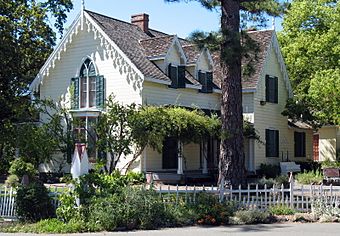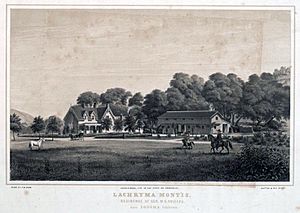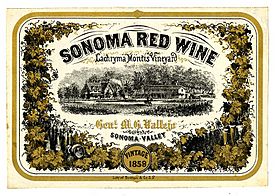Vallejo Estate facts for kids
|
Vallejo Estate
|
|
 |
|
| Location | Corner of Spain and West 3rd Streets, Sonoma, California |
|---|---|
| Built | 1851–1852 |
| Architectural style | Carpenter Gothic—Victorian |
| NRHP reference No. | 72000262 |
Quick facts for kids Significant dates |
|
| Added to NRHP | June 29, 1972 |
The Vallejo Estate is a really old and important house in Sonoma, California. It's part of the Sonoma State Historic Park, which has six special places to visit. A powerful leader named General Mariano Guadalupe Vallejo owned this estate. He was a Californio, which means he was a person of Spanish heritage born in California when it was part of Mexico. He was a military leader and owned a lot of land.
General Vallejo started buying the land for the house in 1849. He had just returned from a big meeting in Monterey where California's first constitution was created. He lived in the house from 1852 until he passed away in 1890. He called his home Lachryma Montis, which means "mountain tear" in Latin. This name was a translation of Chiucuyem, the Native American name for a natural spring on the property.
Contents
Building the Vallejo Estate
General Vallejo's home was built right next to the spring and its pool between 1851 and 1852. This two-story house was made of wood. What's really cool is that it was built in pieces on the East Coast of the United States! Then, it was shipped all the way around Cape Horn (the southern tip of South America) on a sailing ship. Finally, it was put together at its current spot in Sonoma.
The house was designed in a style called Victorian Carpenter Gothic. This style often features fancy wooden decorations. The Vallejo house had a large Gothic-style window in the main bedroom. It also had two porches, dormer windows (windows that stick out from the roof), and beautiful carved wood trim along the edges of the roof.
To keep the house warm in winter and cool in summer, bricks were placed inside the walls. General Vallejo also thought that adobe (a type of sun-dried brick) was good for California's weather. The furniture inside the house was a mix of different styles. It showed Vallejo's Spanish and Mexican background, items from trade with China, and popular American styles. Each room had its own white marble fireplace. Fancy crystal chandeliers, lace curtains, and a beautiful rosewood piano were brought all the way from Europe.
Other Buildings and Gardens
The estate wasn't just the main house. It also had other buildings and small structures. There was a large barn and houses for the people who worked there. The Cook House was a three-room wooden building behind the main house. The cook lived in one room, and the other two rooms were used for preparing and cooking food.
El Delirio was a small wooden building in the garden near the main house. It was a quiet place where the Vallejo family and their guests could relax. In 1852, a special warehouse was built to store wine, fruit, and other farm products. The wood for this building was cut and numbered in Europe before being shipped to California. The bricks for it came as heavy cargo on sailing ships. Later, this building was changed into a home and became known as the "Swiss Chalet."
The gardens were also very special. Grapevines were moved to the new estate, along with many different kinds of fruit trees, decorative trees, and bushes. The driveway was a quarter-mile long and lined with cottonwood trees and Castilian roses. A pathway around the spring's pool was shaded by a vine-covered archway. Many pretty fountains and charming small buildings also decorated the grounds.
Life at the Estate
General Vallejo and his family moved into Lachryma Montis in 1852. He and his wife lived there for over 35 years. Over time, General Vallejo faced many money problems. They had to live more simply and quietly. He eventually lost almost all of his huge land holdings. He even had to sell the vineyard and other parts of the estate that weren't absolutely necessary.
During the 1850s and 1860s, Vallejo became a leader in California's new wine industry. He planted more vineyards and was one of the first people to make wine to sell in the area. However, in the 1870s, tiny insects called Phylloxera attacked his grapevines. This ruined his vineyards and ended his hopes for making wine.
In 1873, he made a deal with two partners to supply water from the estate's pond to the people of Sonoma. They used redwood pipes to carry the water. This gave him some regular income. In 1881, he sold a right-of-way to the Sonoma Valley Railroad, which meant the railroad could build tracks across his property.
The Estate's Legacy
In 1933, the Vallejo home and about 20 acres of the original land were bought by the State of California. This was done to protect and save this important historical place. It also helped preserve the collection of old items and documents from the estate.
On June 29, 1972, the Vallejo Estate was added to the National Register of Historic Places. This is a list of places in the United States that are important to history. It is also California Historical Landmark Number 4 and is part of the Sonoma State Historic Park.
Gallery
-
Wine label, Lachryma Montis Vineyard, Sonoma Red Wine 1858. California Historical Society archives.
See also







